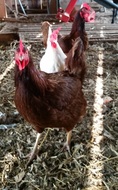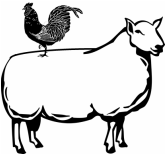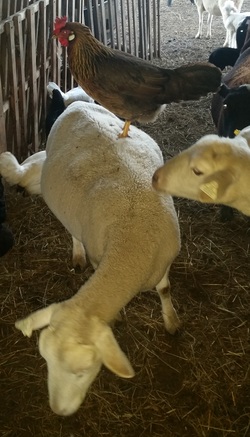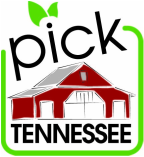About Us

We are located in the foothills of the Smoky Mountains in Sevier Co., Tennessee. Our sheep, pigs and chickens enjoy fresh air, clean water, and 5 acres of pasture 365 days of the year.
We raise wool sheep, including shropshire, icelandic, romeldale, east frisian, and lincoln sheep. We are currently experimenting and researching which wool breeds suit our needs for spinning, needle felting, and other crafts involving wool. I will also be selling wool roving, yarn, and wool crafts a several fiber fairs this spring and fall.
Relatively new to the farm are meat pigs. This will be the third year we will be offering pork and have found Duroc to be mild tasting with just the right amount of fat.
Our chicken flock consists of white Leghorns, which lay white eggs, and Rhode Island Reds, which lay brown eggs. Leghorns are active chickens. They are always willing to work, hunting and scratching, giving no prejudice to flower beds or dung hill; if there is scratching to be done, Leghorns are the chickens for the job. On range they are splendid foragers and small eaters.
The Rhode Island Red is not only America's best known breed, but is perhaps the world's best known fowl. It is the most successful dual purpose bird, and remains an excellent farm chicken.Rhode Island reds are very good layers of brown eggs, perhaps the best layers of all of the dual-purpose breeds.The hens of this breed weigh over 6 pounds. The Rhode Island Red is known for its hardiness and its ability to handle marginal conditions while still producing eggs.
Additionally, eggs from hens raised on pasture may contain: 1/3 less cholesterol, 1/4 less saturated fat, 2/3 more vitamin A, 2 times more omega-3 fatty acids, 3 times more vitamin E, 7 times more beta carotene.
Read more: http://www.motherearthnews.com/real-food/tests-reveal-healthier-eggs.aspx#ixzz383AXXMXS
We raise wool sheep, including shropshire, icelandic, romeldale, east frisian, and lincoln sheep. We are currently experimenting and researching which wool breeds suit our needs for spinning, needle felting, and other crafts involving wool. I will also be selling wool roving, yarn, and wool crafts a several fiber fairs this spring and fall.
Relatively new to the farm are meat pigs. This will be the third year we will be offering pork and have found Duroc to be mild tasting with just the right amount of fat.
Our chicken flock consists of white Leghorns, which lay white eggs, and Rhode Island Reds, which lay brown eggs. Leghorns are active chickens. They are always willing to work, hunting and scratching, giving no prejudice to flower beds or dung hill; if there is scratching to be done, Leghorns are the chickens for the job. On range they are splendid foragers and small eaters.
The Rhode Island Red is not only America's best known breed, but is perhaps the world's best known fowl. It is the most successful dual purpose bird, and remains an excellent farm chicken.Rhode Island reds are very good layers of brown eggs, perhaps the best layers of all of the dual-purpose breeds.The hens of this breed weigh over 6 pounds. The Rhode Island Red is known for its hardiness and its ability to handle marginal conditions while still producing eggs.
Additionally, eggs from hens raised on pasture may contain: 1/3 less cholesterol, 1/4 less saturated fat, 2/3 more vitamin A, 2 times more omega-3 fatty acids, 3 times more vitamin E, 7 times more beta carotene.
Read more: http://www.motherearthnews.com/real-food/tests-reveal-healthier-eggs.aspx#ixzz383AXXMXS


